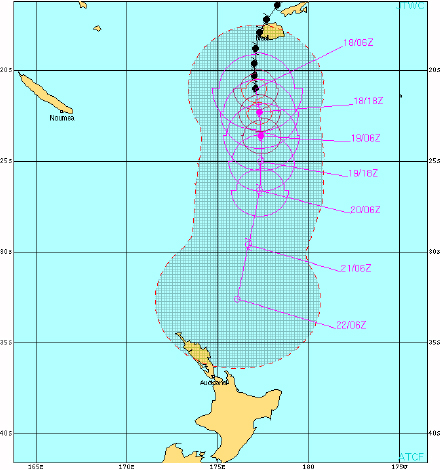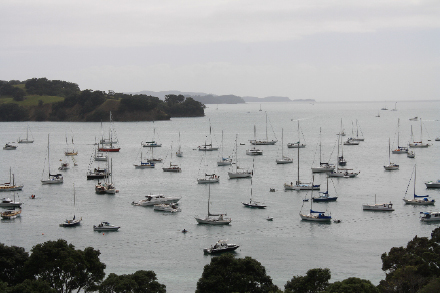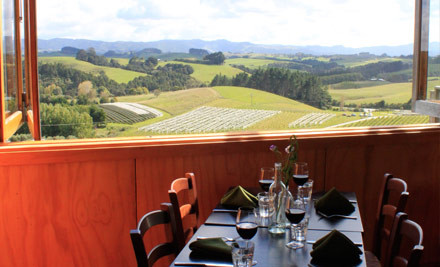Designing the perfect tropical cyclone-proof regatta

Wicked Reminder: While Tropical Cyclone Evan is unlikely to deliver to Northland and Coromandel anything like the misery wrought in Samoa, Wallis, Futuna and Fiji, it is nevertheless a reminder that the Mahurangi Regatta has to be planned in such a way that it can be cancelled at the last minute without resultant financial ruin. chart Joint Typhoon Warning Center Valid 201212180600 UTC
Rodney Local Board would certainly want its $5000 back.
In the event, that is, of a repeat of a visitation by an ex-tropical cyclone the likes of Wilma, which cancelled the 2011 Mahurangi Regatta.
Against the five killed by Tropical Cyclone Evan in Samoa and massive loss of property ill-afforded by the poor of Fiji, the welfare of a mere regatta ranks as barely worthy of consideration. However, scheduled to strike Aotearoa on the weekend, albeit with much diminished wind speeds, Evan is a timely reminder that cancellation is always on the cards. The prevailing neutral El Niño–Southern Oscillation this summer brings an increased risk of an ex-tropical cyclone coinciding with the regatta, including because they are most common January to March.
With the budget for the shoreside events being about $10 000, losses could potentially cripple Mahurangi Action, the organising body most exposed. Bizarrely, a close call by an ex-tropical cyclone could easily be more damaging financially to the regatta’s organisers than a direct hit. In the case of Wilma, it was apparent 40 hours out that the marquee and swing band would have to be cancelled—it was an easily made decision. But where the severity, path and timing of a cyclone allows the sailing regatta to continue, but with few competitors and even fewer spectators, the gold-coin and brown-note donations made on the day could fall forlornly short of what is needed for the event to break even.
The Mahurangi Regatta is a spectacularly successful regional event that nobly bookends, with the Auckland Anniversary Regatta, the region’s annual public holiday weekend. Revived in 1977 by Mahurangi Action, as Friends of the Mahurangi, much of the responsibility, and most of the risk, has stuck with the group, including the bills for St John services and public liability insurance alone come to $1449. The challenge, then, is to plan the event so that it can be cancelled, or scaled back, just days out from the event, without incurring significant loss. This requirement is the principal reason that attendees of the prize-giving dance are now required to bring their own food and drink—the risk is shared by all, rather than only the organisers. It helps that this was the tradition of the regatta, going back at least as far as the 1940s—when the prize-giving dance venue was the Waiwera Gaiety Hall, and the format ‘Ladies a plate’. It also keeps the format consistent with the leave-your-wallet-at-home picnic regatta at Sullivans Bay, and with the regional parks generally.

Good for a Fiver: If, on average, the mostly well-heeled attendees of the Mahurangi Regatta Prize-Giving Dance donated a large gold coin each in return for the hospitality, music and marquee laid on for them, the event would be at no risk of being bankrupted. If the koha was closer to a brown note per person, there would be funds over to put towards the riparian fencing and planting, and projects such as the Mahurangi Farm-Forestry Trail, that are so essential to keeping soil on the hills rather than in the harbour. photographer Crispin Caldicott 2012
Mindful that that the ‘ladies’ might well draw the short straw in the sexual division of labour, there will be a handsome prize for the best bloke-built regatta picnic dinner, and prizes for best child-built and best picnic dinner overall. The principal prize will include a dinner for four at the Mahurangi River Winery and Restaurant. But the purpose of the best bloke-built picnic dinner goes beyond concern for ensuring women aren’t left with sole responsibility for the catering. The main aim is to drive home the message that no food or drink will be on sale at the regatta. Because, while there is little chance of sailors arriving ashore devoid of grog, there is every possibility that some would arrive without adequate grub to soak it up—which could be a recipe for a less than family-friendly gathering.
Featuring the Mahurangi River Winery and Restaurant is the perfect opening for a few words to be said about the Mahurangi Action Plan. In particular, how the owners in partnership with the council’s communities in catchments programme have fenced and planted almost the entire Duck Creek sub-catchment of the Mahurangi Harbour, and how soil erosion is a seriously escalating threat—thanks to global warming, ex-tropical cyclones of increasing intensity will increasingly be visited upon the Mahurangi. Further, how the winery was purchased in pursuit of the owners’ dream of establishing a network of Mahurangi walkways, which is due to begin soon with the Mahurangi Farm-Forestry Trail, supported by Auckland Council, which one day will connect the Mahurangi and Matakana winegrowing areas.

Prize-Winning Landscape: Mahurangi River Winery and Restaurant overlooks landscape that includes Solway Deer Farm, which it also farms and which received the deer industry award for excellence in riparian management. image Mahurangi River Winery and Restaurant
The regatta prize-giving and dance is not a time when folk can be expected to be receptive to a lengthy ‘Save the Mahurangi’ lecture. On the other hand, it is the only natural annual Mahurangi Harbour event, and it is attended by a crowd, of about a thousand that universally values the harbourscape and prefers its waters un-muddied—there is no better time to succinctly say that there is a Mahurangi Action Plan, and it is worthy of the support of regatta-goers, and of Aucklanders in general.
All that remains is to interest an attractive personality to present the prizes and say those few sweet and succinct words.
